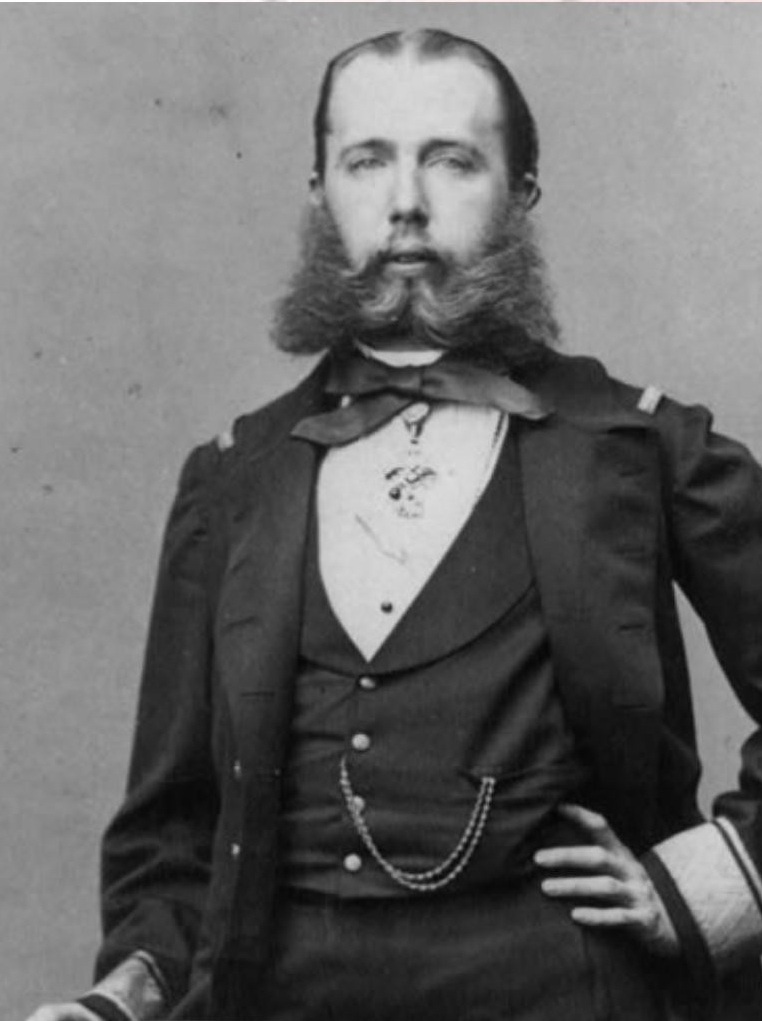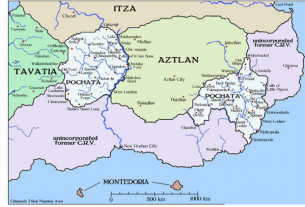By Kirby Vickery from the May 2017 Edition
Quetzalcoatl (pron. Quet-zal-co-at) was one of the most important gods in ancient Mesoamerica. The god 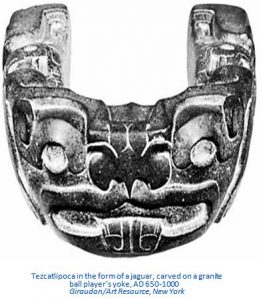 known as the Plumed Serpent is a mixture of bird and rattlesnake. Quetzalcoatl’s name is a combination of the Nahuatl words for the quetzal the emerald plumed bird and coatl or serpent. He was around long before the Aztecs came into power. To the Maya he was known as Kukulkán. The Quiché of Guatemala called him Gucumatz. To the Huastecs of the Gulf Coast he was Ehecatl. He was regarded as the god of winds and rain and as the creator of the world and mankind.
known as the Plumed Serpent is a mixture of bird and rattlesnake. Quetzalcoatl’s name is a combination of the Nahuatl words for the quetzal the emerald plumed bird and coatl or serpent. He was around long before the Aztecs came into power. To the Maya he was known as Kukulkán. The Quiché of Guatemala called him Gucumatz. To the Huastecs of the Gulf Coast he was Ehecatl. He was regarded as the god of winds and rain and as the creator of the world and mankind.
In Central Mexico, from 1200 CE, he was also considered the patron god of priests and merchants and considered the god of learning, science, agriculture, crafts and the arts. He also invented the calendar, was identified with Venus, the rising morn- ing star, he was associated with opossums and even discovered corn (maize) with the help of giant red ant that led him to a mountain packed full of grain and seeds.
Quetzalcoatl was the son of the primordial androgynous god Ometeotl. In Aztec mythology he was the brother of Tezcatlipoca, Huitzilopochtli and Xipe Totec.
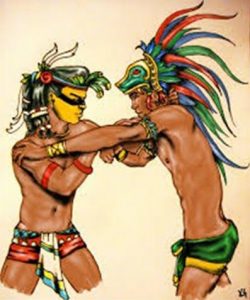 In my musings over Aztec mythology, I sometimes look at other mythologies, if for no other reason to run a comparison or two. I remember having heard that one of the reasons Cortez was able to defeat Montezuma II, and assume control over the Aztec empire, was that he learned that he looked like (resembled) Quetzalcoatl or that of his emissary, to the Aztecs. So instead of being a concurring Spaniard, he was the return- ing God Quetzalcoatl and was welcomed with open arms. While it cut down on his losses back then, it sure made me sit up and wonder why today.
In my musings over Aztec mythology, I sometimes look at other mythologies, if for no other reason to run a comparison or two. I remember having heard that one of the reasons Cortez was able to defeat Montezuma II, and assume control over the Aztec empire, was that he learned that he looked like (resembled) Quetzalcoatl or that of his emissary, to the Aztecs. So instead of being a concurring Spaniard, he was the return- ing God Quetzalcoatl and was welcomed with open arms. While it cut down on his losses back then, it sure made me sit up and wonder why today.
Why would the Rain and Life God of Venus disappear to begin with after his creation started to go so well? His planned return, I understood, was the answer. What I found out about other mythologies was very interesting. In both the Greek and Roman mythologies, the creation of everything is very convoluted and complicated. In Norse mythology, Thor, it seems, is always fighting his brother Loki, for one reason or another. Cain fought his brother Abel in the Bible.
The Pre-Christian god Baal had one heck of a time fighting his brother for control over the earth and its 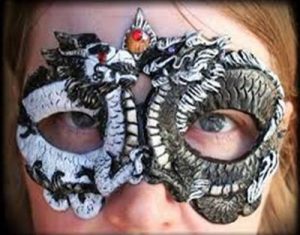 people. So much so he required the help of his mother to win the battle. The unanswered question is why do all these senior gods end up fighting their own brothers for control of mankind? The answered question is, in Quetzalcoatl’s case, because of his brothers (three, actually) and what they did to him and his people. The Codex revealed four stories of the bad poking at the good and disrupting everything which caused Quetzalcoatl to want to leave. The first of the four is below for your reading enjoyment.
people. So much so he required the help of his mother to win the battle. The unanswered question is why do all these senior gods end up fighting their own brothers for control of mankind? The answered question is, in Quetzalcoatl’s case, because of his brothers (three, actually) and what they did to him and his people. The Codex revealed four stories of the bad poking at the good and disrupting everything which caused Quetzalcoatl to want to leave. The first of the four is below for your reading enjoyment.
In the days of Quetzalcoatl, there was abundance of everything necessary for subsistence. The maize was plentiful, the calabashes were as thick as one’s arm, and cotton grew in all col- ours without having to be dyed. A variety of birds of rich plum- age filled the air with their songs, and gold, silver, and precious stones were abundant. In the reign of Quetzalcoatl, there was peace and plenty for all men.
But this blissful state was too fortunate, too happy to endure. Envious of the calm enjoyment of the god and his people the Toltecs, three wicked “necromancers” plotted their downfall. The reference is of course to the gods of the invading Nahua tribes, the deities Huitzilopochtli, Titlacahjuan or Tezcatlipoca, and Tla- cahuepan. These laid evil enchantments upon the lead in these envious conspiracies.
Disguised as an aged man with white hair, he presented himself at the palace of Quetzalcoatl, where he said to the pages-in- waiting: “Pray present me to your king I desire to speak with him.” The pages advised him to retire, as Quetzalcoatl was in- disposed and could see no one. He requested them, however, to tell the god that he was waiting outside. They did so, and procured his admittance.
On entering the chamber of Quetzalcoatl, the wily Tezcatlipoca simulated much sympathy with the suffering god-king. “How are you, my son?” he asked. “I have brought you a drug which you should drink, and which will put an end to the course of your malady.”
“I thank you kind sir,” replied Quetzalcoatl. “I have known for many days that you would come. I am exceedingly indisposed. The malady affects my entire system, and I can use neither my hands nor feet.”
Tezcatlipoca assured him that if he partook of the medicine which he had brought him, he would immediately experience a great improvement in health. Quetzalcoatl drank the potion, and at once felt much revived. The cunning Tezcatlipoca pressed another and still another cup of the potion upon him, as it was nothing but pulque. Pulque is an alcoholic beverage made from the fermented sap of the maguey plant. It is tradi- tional to central Mexico, where it has been produced for mil- lennia. It has the color of milk, somewhat viscous consistency and a sour yeast-like taste. He speedily became intoxicated, and was as wax in the hands of his adversary to commit all sorts of debauchery thru forcing him out of the land.
This was the first incursion that Tezcatlipoca used to cause the death of many Toltecs by his black magic and induction of the virtuous Quetzalcoatl into sin, drunkenness, and carnal love, thus putting an end to the Toltec golden age. It was under his influence the practice of human sacrifice was introduced into central Mexico. In the months to come I will tell of the other three tales.
Download the full edition or view it online
—
Kirby was born in a little burg just south of El Paso, Texas called Fabens. As he understand it, they we were passing through. His history reads like a road atlas. By the time he started school, he had lived in five places in two states. By the time he started high school, that list went to five states, four countries on three continents. Then he joined the Air Force after high school and one year of college and spent 23 years stationed in eleven or twelve places and traveled all over the place doing administrative, security, and electronic things. His final stay was being in charge of Air Force Recruiting in San Diego, Imperial, and Yuma counties. Upon retirement he went back to New England as a Quality Assurance Manager in electronics manufacturing before he was moved to Production Manager for the company’s Mexico operations. He moved to the Phoenix area and finally got his education and ended up teaching. He parted with the university and moved to Whidbey Island, Washington where he was introduced to Manzanillo, Mexico. It was there that he started to publish his monthly article for the Manzanillo Sun. He currently reside in Coupeville, WA, Edmonton, AB, and Manzanillo, Colima, Mexico, depending on whose having what medical problems and the time of year. His time is spent dieting, writing his second book, various articles and short stories, and sightseeing Canada, although that seems to be limited in the winter up there.


